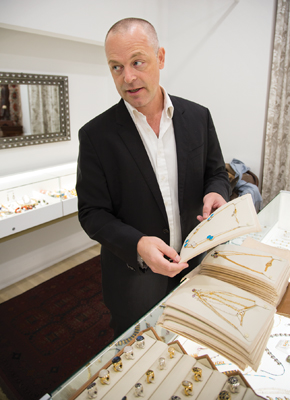From Cowboy Country to Kathmandu
A combination of creativity and confidence grounds Stephen Estelle ’93 in the business world

Stephen Estelle ’93, shown at Bella Turka, a Philadelphia jewelry store, says he keeps his business focused on the Buddhist ideal of compassion. Koray Avci, who owns Bella Turka, also notes that Estelle’s business is built on trust. He says that after meeting Estelle briefly several years ago, Estelle sent him a box containing “tons of jewelry. He said, ‘Pick what you want. If you sell it, send me the money and just return the pieces you don’t sell."
Stephen Estelle ’93 is an example of what happens when West meets East. As a kid, he rode horses on his family’s Montana ranch. In his late 20s, he exported his equestrian experience, leading 200-mile treks across the Tibetan plateau on horseback. “It was like the wild west, circa 1870,” he says. “You could ride for weeks without seeing a road or fence—just yaks, nomads, and the occasional meditator sitting on a hillside or in a cave.”
Transferring that early cowboy-country experience to a far-flung land seemed logical to Estelle, who had learned Himalayan languages in Nepal. “I grew up on a ranch and spoke Tibetan, so why don’t I lead trips?” he thought, adding, “I can do this in the summer and make some money.”
Estelle no longer leads horse trips, but the Himalayan region still provides his spiritual—and economic—base.
Estelle, whose penchant for living in places renowned for natural beauty remains unabated, now resides in Kilauea, Hawaii, with his wife and son but spends much of the year traveling the United States’ East and West coasts.
As president and creative director of Stephen Estelle Jewelry, he visits small boutique jewelry stores like Bella Turka in Center City Philadelphia, showing new designs to shop owners or displaying his elegant yet simple rings, bracelets, earrings and other pieces of women’s jewelry to customers during special store events. All pieces are handcrafted in Nepal by eight craftspeople who employ gold, silver, and stones such as labradorite to translate Estelle’s designs into smooth, clean jewelry that has an average retail cost of $350 per piece.
Explaining his design process, Estelle says, “I start with something intricate, then strip away, editing elements out until they are down to the purist form.”
Estelle’s journey from a 12-student classroom in a tiny ranch school 70 miles from the nearest city, to Swarthmore, then to the top of the world, where he designs jewelry with a family of goldsmiths, may seem accidental. But when you learn his father is a rancher and geologist for the oil business and mother is an artist, his career as an artistic entrepreneur makes sense.
At Swarthmore, the French major and religious studies minor learned about world religions but gravitated after graduation to a branch of Buddhism based on compassion and centered in a Tibetan refugee settlement in Nepal. “I made a 180-degree pivot to Nepal,” he says. “The philosophy is incredibly rigorous. I thought I was a pretty smart guy coming out of Swarthmore, but when I started debating Tibetan lamas and lost every time, I was impressed.”
But before making that ultimate shift to Nepal, Estelle spent two years as social coordinator for Swarthmore’s president’s office. In that role, he met a Board member who would be a critical catalyst in his journey East. “Jerry Kohlberg [’46] was very important for me,” says Estelle.
When Estelle decided he wanted to move to Nepal to set up a school for translators of Himalayan languages, Kohlberg offered aid. “Jerry thought the project was compelling and funded me for two years to travel to Nepal,” he says. “I owe him a tremendous debt.”
With Kohlberg’s boost, Estelle left the College in 1996 to become a founding member and director of Rangjung Yeshe Shedra, a traditional Tibetan Buddhist monastic college in the Kathmandu Valley that is attached to a monastery led by the Tibetan lama Chokyi Nyima Rinpoche. The school offers bachelor’s and graduates degrees in Buddhist philosophy and Himalayan languages.
Through his work with the school Estelle met the family whose jewelry-craft lineage dates to the 1780s. He started his company in 1998 and spends every November working on new designs with the smiths in the afternoons, studying in the Rangjung Yeshe monastery in the morning. “I work hard for bursts of time, then study,” he says with a smile. “It’s a nice combination.” As is his blend of creative and business sensibilities.
“The creative side is a joy—coming up with new designs and ideas,” he says. “But to succeed in business you need to communicate well and have a certain amount of confidence—to go out and try it. I came out of Swarthmore feeling I had a good, solid mind and that what I was doing was valuable.”
Besides instilling confidence, he says, “my Swarthmore education provided me with freedom. I have the background to make a choice, whatever that choice is. You choose the path and craft the life that’s right for you.”
 Email This Page
Email This Page